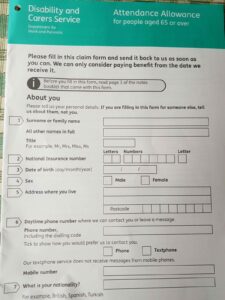Proposed welfare benefit cuts are set to bring significant changes to disability benefits, particularly Personal Independence Payment (PIP) Universal Credit (UC), and the broader social support systems.
Britain’s benefits system is the “worst of all worlds”, with the number of people out of work or training “indefensible and unfair”, the prime minister said recently as he prepares for a green paper on sickness and disability benefit changes and deep cuts to disability payments.
While the government argues that welfare benefit cuts will promote financial sustainability and encourage employment, the reality for those affected is starkly different.
This blog explores the likely impact of these cuts, including key statistics, case studies, and the role of Care Navigators in helping challenge PIP decisions.
Key Statistics on Welfare Cuts and Social Support
- Welfare spending is projected to reach £378 billion by the end of the decade, prompting government interventions to cut costs.
- Nearly 3 million people currently receive PIP, with many at risk of losing support under the proposed stricter eligibility criteria.
- The number of appeals for PIP decisions has surged, with 68% of appeals upheld in favour of claimants—indicating systemic flaws in the assessment process.
- NHS mental health services are already under strain, with waiting times for therapy exceeding 18 weeks in many areas, leaving those affected without immediate support.
- A 2024 study found that 1 in 4 disabled individuals have had to cut back on food and energy costs due to benefit reductions.
The Fragmentation of Public Services: A Domino Effect
Welfare cuts do not exist in isolation. When one department faces budget reductions, the strain is inevitably felt elsewhere, creating a ripple effect:
- Cuts to PIP and Universal Credit: More people struggle to afford necessities, increasing their reliance on NHS services, food banks, and mental health support.
- Reduced access to GP and mental health services: People with disabilities and long-term conditions are left unsupported, worsening health outcomes and increasing hospital admissions.
- Increased pressure on the NHS: Studies show that reductions in welfare support lead to higher GP visits, emergency admissions, increased suicide and self-harm, an increase in waiting lists and long-term care costs.
- Rising costs for the judicial system: As more claimants challenge PIP decisions, tribunal costs continue to escalate, burdening an already stretched legal system.
A Short-Sighted Approach? The Real Cost of Cutting Benefits
The government frames welfare cuts as a necessary step toward economic stability. However, without considering the broader impact, these cuts risk shifting costs elsewhere, ultimately leading to:
- Higher NHS costs due to worsening health conditions.
- Increased strain on social services and charities.
- A rise in homelessness and food insecurity.
- A growing burden on the legal system due to the spike in benefit appeals.
- A very real human cost, increased suicide and self-harming, social isolation and inability to work
- Reducing PIP claimants will not affect employment potential. The result will not be more people back into work but more people without lifeline benefits in need of more services. Our current system is a pass or fail, work or don’t work system, it doesn’t allow for half way, part time or supported roles. Changing the typical requirement for a ‘working week’ and supporting people back into a varied settings and roles would cost too much!
The Human Cost of Welfare Cuts
For many, PIP is a lifeline that enables them to maintain independence and access essential support. Below are real-life examples of individuals affected by recent cuts and changes to PIP applications:
Case Study 1: Sarah’s Fight for PIP
Sarah, 45, was diagnosed with multiple sclerosis three years ago. Despite worsening mobility and chronic pain, her PIP reassessment resulted in a reduction in her award. Unable to afford mobility aids and transport to medical appointments, Sarah became increasingly isolated. With Care Navigators’ support, she successfully challenged the decision, securing the higher rate of PIP she was initially entitled to.
Case Study 2: Mark’s Struggle with Mental Health Support
Mark, 29, has severe anxiety and depression, making it difficult to work. After his PIP was reduced, he could no longer afford therapy sessions, and his mental health deteriorated. The local NHS mental health service had an 8-month waiting list. Care Navigators helped him navigate the appeals process, ensuring he received the correct level of support while also connecting him with local advocacy groups.
Conclusion: A Need for Holistic Reform
The debate on welfare reform should not be reduced to simple cost-cutting measures. The true cost of inaction—failing to support the most vulnerable—must be weighed against the supposed savings from benefit reductions. Unless the government takes a holistic approach that considers healthcare, legal, and social services, these reforms risk creating more problems than they solve.
Care Navigators: Helping You Challenge PIP Decisions
With government cuts increasing pressure on disabled people, it’s more important than ever to know your rights.
Care Navigators offers:
- Expert guidance on PIP applications and appeals to help secure the right level of support.
- Advice on accessing additional benefits and completing the application forms such as Attendance Allowance and Carer’s Allowance.
- Support in navigating healthcare services, ensuring you receive the care and support (and funding) you need despite increasing service limitations.
If you or a loved one are struggling with benefit reductions or an appeal, Care Navigators is here to help. Contact Us today for expert guidance and support in securing the benefits you deserve.







